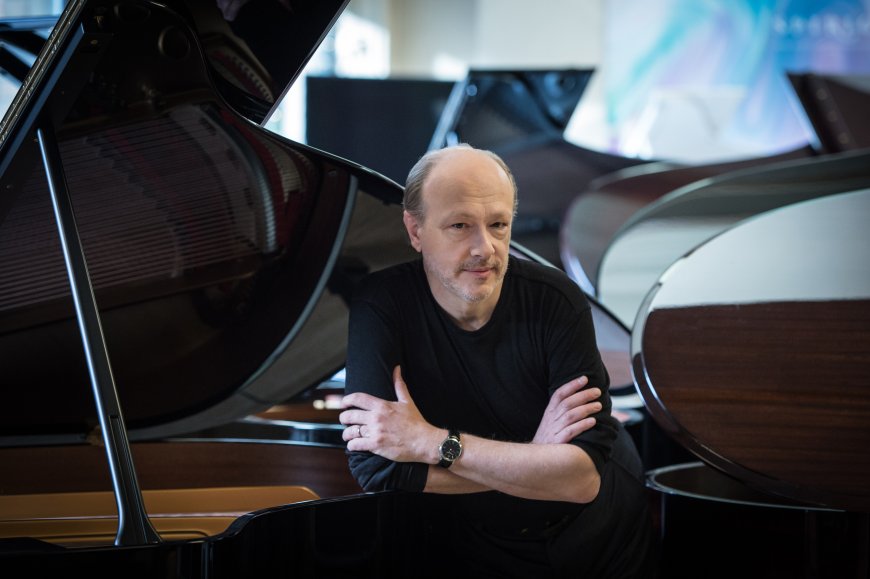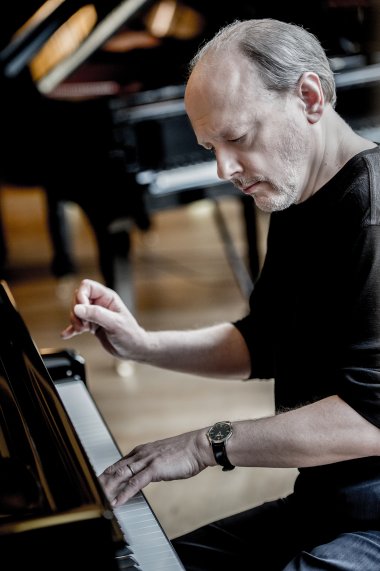
For most pianists, Beethoven’s “Hammerklavier” or Maurice Ravel’s Gaspard de la nuit would be challenge enough to anchor a recital. Not so for Canadian pianist Marc-André Hamelin, who presented a formidable solo program at Davies Symphony Hall on Sunday night, tackling both of these monumental works along with Schumann’s Waldszenen.
The result was nothing short of awe-inspiring. Hamelin allows his technique to serve as a conduit through which a composer’s music can reach the audience, and on this weekend’s program the pianist honored each piece via his virtuosity. The result was not one of grandiosity but rather one of humility: Hamelin positioned himself as a mere spokesman for the great composers. The audience lauded Hamelin with standing ovations both before and after intermission.
The first piece on the program was Beethoven’s Piano Sonata No. 29 (“Hammerklavier”). The German term for piano has perhaps stuck as the sonata’s nickname because it evokes the power of the hammer, and indeed the “Hammerklavier” is one of Beethoven’s most difficult piano sonatas. But Hamelin did not shy away from Beethoven’s demands for strength: beginning vigorously, he played the Allegro’s introductory chords with a tone rich enough to fill the entire hall. The first theme and each that followed possessed a unique dynamic and temperament, and Hamelin paid remarkable attention to the sudden contrasts and careful development that marked this many-themed Allegro. Hamelin’s Scherzo was similarly full of character and even humor, fitting for the movement’s jittery nature.

The following Adagio was beautifully languid. Hamelin paused just so before each chord enveloped the audience like a soft, snug blanket. Yet the melodies never disappeared into their folds: each danced through the fabric of Hamelin’s chords. Beethoven’s longest movement in a piano sonata felt short in Hamelin’s hands, and his transition into the final movement was magical.
After a slow but forward-moving Largo, Hamelin closed off Beethoven’s “Hammerklavier” with a furious fugue. At one point he even nodded to the fugue’s driving beat like a rock musician. The hall’s reverberant acoustics did not do justice to Hamelin’s dexterity, but even so, the clarity of each note spoke to Hamelin’s masterful technique and pedaling. The final chord was met with thunderous applause and a standing ovation.
After intermission, Hamelin returned onstage to play Schumann’s Waldszenen (Forest scenes), a set of nine pieces depicting the woods. Hamelin’s performance was romantic, pictorial, and garnished with the perfect amount of rubato: melodies sweetened the petals of Einsame Blumen (Lonely Flowers), darkness settled into the rests of Verrufene Stelle (Haunted place), fragility and weight mounted each wing of Vogel als Prophet (Bird as prophet), and triumph marked the bold Jagdlied (Hunting song). Given the hall’s acoustics, the softness of Hamelin’s touch was an impressive feat. Abschied (Farewell) concluded this journey through the forest, and Hamelin played it with a bittersweet finality.
Last on the program was Ravel’s imposing Gaspard de la nuit. Based on an eponymous collection of poems by the French Romantic poet Aloysius Bertrand, Gaspard is a suite of three pieces that are both intensely virtuosic and profoundly haunting. First, Hamelin began Ondine with an extraordinary lightness, his fingers moving with seemingly no effort at all. Despite the flurry of notes that distinguishes Ondine, Hamelin’s touch remained delicate even on the peaks of crescendos, and only once in the entire movement did he unleash all of his strength.
Hamelin’s Le gibet was as slow as it needed to be: weighty and solemn, each chord resonated in the soul, conjuring up the power of the setting sun. Hamelin kept the ringing B-flat clear throughout, letting it die only at the movement’s finish. Perhaps the slowness verged on excessive toward the end, and the silence between Le gibet and the following movement was short, preventing the final B-flat from passing away properly.
But Hamelin’s Scarbo more than made up for it. Jerking the audience into the world of the sinister, Hamelin performed with dynamic caprice, playing whimsically with the pauses and fortes that characterize the movement. His dexterous fingers evoked the tiny footsteps of the mischievous dwarf who inspired Scarbo, and thus it was not the pianist but the dwarf who emerged into the foreground of the performance.
Scarbo’s conclusion prompted another standing ovation, and Hamelin indulged the audience with five encores ranging from Debussy to Rachmaninoff to his own compositions.
Watch SFCV's Virtual Greenroom interview with Marc-André Hamelin, moderated by writer Steven Winn, here:




